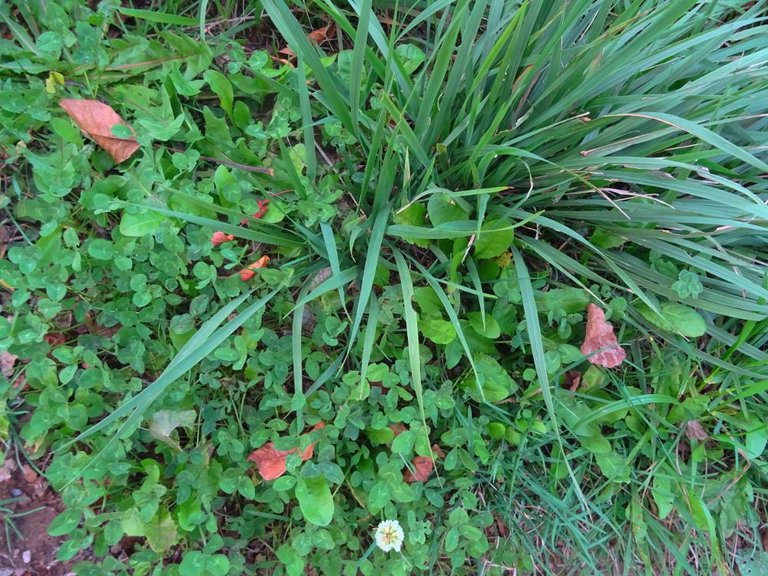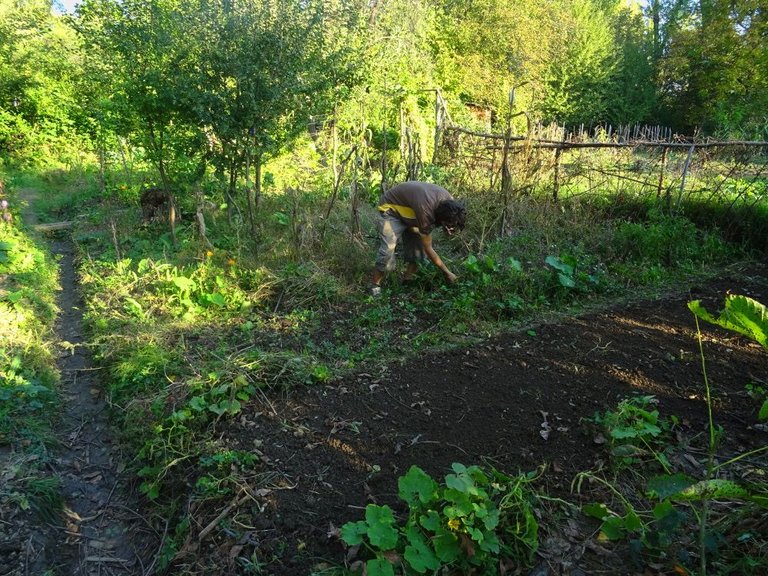If your garden can be green all-year long, why not? All of the crops we grow take up nutrients from the soil and offer it to us in form of their leaves, fruits, vegetables, roots, nuts or something else... By eating plants, we take those nutrients from the ground and put it in our bodies... Some leach out due to irrigation, some erode down the hill and some evaporate due to sunlight exposure. What if we could put an end to all of this? I'm not saying green manure will solve all of the said problems to the end, but it will definitely help alongside other methods. Unlike the crops, some plants we grow in an agricultural setting don't offer anything to us, but they offer much to the soil. These are the most resilient plants, plants that help fix nitrogen from the air to the ground, use the sun to turn co2 into organic matter, work with mushrooms to mine minerals from stones, serve as a ground cover and break & crumble up the soil with their expansive roots. What if we could grow food intensively during the season and fertilize, protect and repair our soil structure during the winter?
What's green manure?
From my humble understanding, green manure or sideration is a simulation of the meadow stage of ecosystem development in natural succession. Meadows consist of pioneer plants which heal the soil. Grasses cover and loosen the topsoil, legumes fix nitrogen and deep root plants bring back up nutrients from the lower layers to the topsoil where our veggies need them.
Below, an unidentified grass plant, white clover and chicory remediating the soil,
Let's put an end to the end...
I've always loved the idea of fertilizing the soil without leaving it fallow or adding in any organic matter or chemical fertilizer, and I've heard of green manure a long time ago. The idea was idle in my mind until this spring, a friend and I tryed it out in his brand new orchard (story is featured shortly in this article)... We transplanted some fruit trees into an old garden with over-used soil and sowed the area with clover. Unfortunately, this summer was so dry nothing came up until the first fall rains. Now it's thriving... I wish I'm a math kinda guy, I would now amaze you with the amount of nitrogen that will be fixed over the next few years... The only thing I can do is tell you about the theory I know and what I learned from my agricultural practice.
We used far more seed than it is recommended to use per hectar of land... That might be the reason why it came up in such bounty. The plants aren't taller than a standing mouse, but they are so dense the ground under them is constantly in deep shade. I thought, we should have planted a variety of plants, not just one species. So I ventured out to the nearest agriculture shop and bought white, red clover and lolium multiflorum, a ryegrass plant seeds. I wanted even more, but that's all they got... So I did some experiments, planted beds with a singular species, with two, with three, with different amounts of seed, we'll see how it goes, I'll give my best to keep the evidence clear.
Now, let's proceed with some of the things green manure could help us with:
Hard work
Probably the best of all, green manure helps keep the soil loose. If you don't use heavy machinery and you don't step on your beds, the one and only reason for you to dig or till the soil might be the rain. Imagine a rain drop, I know, it's not that heavy, but imagine it falling from the sky, with kilometers of gravitation to speed it up... Now imagine millions of them hitting a spot every now and then during a few years...
“The ultimate goal of farming is not the growing of crops, but the cultivation and perfection of human beings.”
― Masanobu Fukuoka
You get the point, you need something to amortize the impact of the raindrops. One solution for this is mulch. If you need to cover a little bit larger space, you'll either need to pay for the material or gather it yourself (which is hard work)... So save some money and some time and sow live mulch! It's the evergreen (no pun intended) gardening hit!
Below, seedlings of lolium multiflorum, red and white clovers just starting to re-cover the soil,
Nitrogen
We all know it, nitrogen really means a lot to our plants. Let it evaporate and leach out, drain your soil with nitrogen heavy plants, soon you'll have a desert with some yellow-leaved plants. One funny little thing that happens when you plant clover (or other legumes) is that a bacteria attacks it's roots. The plant defends itself by encapsulating it's enemy, and the bacteria responds by fixing nitrogen, while the plant feeds the bacteria with sweet sugar it makes from scratch (and the sun)... Perfect symbiosis I guess... Infact, it's an ultimatum. The plant told the bacteria: "Either you are going to work for me, or I'll suffocate you..."
Water and minerals
A large number of plant species use mushrooms to help them with water and mineral needs. Plants can only drink minerals, while mushrooms can dilute them with their acids. It has been estimated that 95% of plant species engage in this symbiotic relationship. In a world where the weather is definitely warming up due to humanity's way of existance, Mycorrhizal fungi might be the number one solution, because they amazingly extend the root's surface reducing the need for water. Did you know that only the tip of the root is what takes up nutrients and water?
“We are not at the end of a rope, as it’s so easy to think. Humanity can yet choose to turn direction. The moment has come to leap into action with glad hearts. The seeds are germinating. The fungi are willing. And we must be, too.”
― Michael Phillips
If the plant is infected with symbiotic fungi, the whole root can take up what the plant needs... Not only that, but it spreads in all directions, effectively maximising it's work area. Mycorrhizas are naturally abundant in undisturbed soil, but by taking all the weeds out we leave no roots in the ground for them to symbiosize with. Planting green manure mixes in the fall might help this, because it bridges the part of the year which is usually devoid of live plant roots with the root-abundant season... In this way, everyone is covered (the mushroom, the bacteria, the plant and the human)!
So, how should we go about doing this?
You can always look online for tips, tricks and recipes for the amount of seed and seed mix... That's not me tho'... I like doing everything myself. If there's not a scientific study about it, I'll probably do the trial and error every single time. You can also do that, and we can share results with each other, or you can wait for next winter while I finish my experiments.
I do it by pulling the weeds with the roots and cutting the crop residue, leaving the roots in the ground, turning and raking the top 5 cm of soil (note that my soil has a good structure even tho' it's a mostly clay type soil - I'll be making a post about soil structure alone), sowing and gently raking the seed in. It all came up in less than a week, so it means it's effective. The rule of (the green) thumb goes, the seed must go the ground as deep as it is big (so a 1-cm seed must be covered with 1 cm of soil), but to prevent sending an open invitation to the birds, I raked it all to a cm or two of depth, even tho' the clover seed is less than a mm in diameter (Lolium is bigger). I will leave it as it is during the winter, maybe I'll plant some salad greens between the green manure in the mean time. In spring, when the time to plant comes, I'll turn the green manure to the topsoil. It will stop from growing it, an even more importantly, from going to seed. If you let your plants go the flower or even seed, you'll probably waste all of the nutrients the plants gathered over time, since flower and seed production is an energy-intensive process.
Below, a friend helping me clean out a bed for sideration,
Keeping the ground green all year long will definitely have some benefits... If it can help us with using less fertilizer, less irrigation and doing less work, I guess it's worth doing it. When the cold weather comes, I will be posting updates on this green manure experiment. I hope to find the best mix and to share it with all of you... I sincerely believe knowledge should be free, but people sharing it should be awarded. That's why I feel I must write an article about it in the future "Why Steemit is totally a permacultural thing?"... :)
You all be well and feel free to write down your experiences with green manure in the comments, it might help me or somebody else... Stay tuned, follow if you like the content, I'll check out your blog, let me know by upvoting! <3
BTW - We've been much to the mountain lately, chestnut and mushroom foraging... I can't wait to share some pictures and knowledge with you guys! :)




Congratulations @freegardens, this post is the most rewarded post (based on pending payouts) in the last 12 hours written by a Dust account holder (accounts that hold between 0 and 0.01 Mega Vests). The total number of posts by Dust account holders during this period was 2680 and the total pending payments to posts in this category was $363.10. To see the full list of highest paid posts across all accounts categories, click here.
If you do not wish to receive these messages in future, please reply stop to this comment.
@freegardens the topic of this article is pretty good. Really, isn't it the most useful way to use the shit.
When someone gives you shit, add it to your soil. lol
Hahah! Shit with no smell or pathogens... You're right, might be the best 'manure' :D
@reported has voted on behalf of @minnowpond. If you would like to recieve upvotes from minnowponds team on all your posts, simply FOLLOW @minnowpond.
To receive an upvote send 0.25 SBD to @minnowpond with your posts url as the memo To receive an reSteem send 0.75 SBD to @minnowpond with your posts url as the memo To receive an upvote and a reSteem send 1.00SBD to @minnowpond with your posts url as the memoCongratulations, your post received one of the top 10 most powerful upvotes in the last 12 hours. You received an upvote from @curie valued at 41.01 SBD, based on the pending payout at the time the data was extracted.
If you do not wish to receive these messages in future, reply with the word "stop".
great information sir keep it up
well thank you very much kind lady :) steem on
Hey, great post @ freegardens! I am your fan now. :)